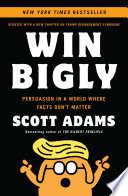

In 'Win Bigly', Scott Adams emphasizes the significance of persuasion over mere facts in influencing people's opinions and decisions. He argues that effective persuasion relies on emotional appeal rather than logical reasoning. This is particularly relevant in politics, advertising, and personal interactions. Adams illustrates this concept through the 2016 U.S. presidential election, highlighting how Donald Trump utilized persuasive techniques to sway voters. The book explains that persuasion can create a reality that may not align with factual evidence but resonates with people's emotions and beliefs. By understanding the mechanics of persuasion, individuals can enhance their communication skills and become more effective in their endeavors.
Continue readingAdams introduces the concept of visual thinking and how it influences decision-making. He explains that humans often rely on visual cues and mental shortcuts to process information. This is linked to cognitive dissonance, where individuals hold conflicting beliefs and seek to resolve this discomfort by aligning their thoughts with their actions. Adams argues that successful persuaders create compelling visuals and narratives that help audiences resolve their cognitive dissonance, leading them to adopt particular viewpoints. This idea encourages readers to harness the power of visuals in their communication strategies, whether in marketing or personal interactions, to enhance their persuasive impact.
Continue readingIdentity plays a crucial role in how people perceive information and make decisions. Adams discusses how individuals often align their beliefs with those of their social groups, leading to groupthink and confirmation bias. This idea illustrates that persuaders must understand the identities of their audiences to tailor their messages effectively. By appealing to shared identities and values, persuaders can foster a sense of belonging and loyalty among their audience. Adams emphasizes that recognizing and leveraging these identity dynamics can significantly enhance the effectiveness of persuasive efforts, whether in politics, business, or personal relationships.
Continue readingHumor is a powerful tool in persuasion, as it can disarm audiences and make them more receptive to messages. Adams highlights how humor can create a positive emotional connection between the persuader and the audience, facilitating trust and openness. He cites examples from Trump's campaign, where humor was used to deflect criticism and engage supporters. The book suggests that incorporating humor into communication strategies can enhance relatability and make complex ideas more digestible. Readers are encouraged to embrace humor as a means of connecting with others and improving their persuasive abilities.
Continue readingAdams introduces the term 'Master Persuader' to describe individuals who excel at influencing others. He outlines the traits and skills that characterize these individuals, such as empathy, adaptability, and a deep understanding of human psychology. The book emphasizes that anyone can develop their persuasive skills by studying and practicing these traits. Adams encourages readers to observe and learn from effective persuaders in various fields, as this can lead to personal growth and improved communication. The concept of the 'Master Persuader' serves as a motivational framework for readers aspiring to enhance their influence and effectiveness in their personal and professional lives.
Continue readingAdams warns against the pitfalls of relying solely on facts when trying to persuade others. He argues that facts alone do not guarantee persuasion, as people often filter information through their biases and emotions. This can lead to a disconnect between factual evidence and public perception. The book highlights the importance of framing information in a way that resonates with the audience's beliefs and emotions. By recognizing the limitations of facts as persuasive tools, readers can adopt more effective communication strategies that prioritize emotional connection and relatability over cold, hard data.
Continue readingIn the final sections of the book, Adams explores the evolving landscape of persuasion in the digital age. He discusses how social media and online platforms have transformed the way information is shared and consumed. The book emphasizes that digital communication requires new strategies for effective persuasion, as audiences are bombarded with information and competing narratives. Adams encourages readers to adapt their approaches to leverage digital tools and techniques, such as storytelling and engaging visuals, to capture attention and influence opinions. This idea serves as a call to action for individuals and organizations to innovate their communication strategies in an increasingly complex and fast-paced digital environment.
Continue readingThe reading time for Win Bigly depends on the reader's pace. However, this concise book summary covers the 7 key ideas from Win Bigly, allowing you to quickly understand the main concepts, insights, and practical applications in around 18 minutes.
Win Bigly is definitely worth reading. The book covers essential topics including The Power of Persuasion, Visual Thinking and Cognitive Dissonance, The Importance of Identity and Group Affiliation, providing practical insights and actionable advice. Whether you read the full book or our concise summary, Win Bigly delivers valuable knowledge that can help you improve your understanding and apply these concepts in your personal or professional life.
Win Bigly was written by Scott Adams.
If you enjoyed Win Bigly by Scott Adams and want to explore similar topics or deepen your understanding, we highly recommend these related book summaries:
These books cover related themes, complementary concepts, and will help you build upon the knowledge gained from Win Bigly. Each of these summaries provides concise insights that can further enhance your understanding and practical application of the ideas presented in Win Bigly.